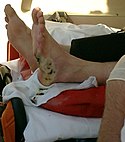John Feeks Western Union lineman killed by AC October 11 1889
On October 11, 1889, in New York City in a Downtown Manhattan district, Western Union lineman John Feeks was high up in the tangle of overhead electrical wires working on what were supposed to be low-voltage telegraph lines. As the lunchtime crowd below looked on he grabbed a nearby line that, unknown to him, had been shorted many blocks away with a high-voltage alternating-current line. The jolt entered through his bare right hand and exited his left steel-studded climbing boot. He was killed almost instantly, but his body fell into the tangle of wire and was cut open, bleeding, sparking, burning, and smoldered for the better part of an hour while a horrified crowd of thousands gathered below. Where the power came from that killed Feeks was never determined, although The United States Illuminating Company had alternating-current lines carrying many thousands of volts that ran nearby.
Obituary
(The Wellsboro Agitator, Tuesday, October 15, 1889, Wellsboro, Tioga Co, Pa.)
Relevante Bilder
Relevante Artikel
StromunfallAls Stromunfall, Elektrounfall, auch elektrischer Schlag oder Stromschlag wird eine Verletzung durch die Einwirkung elektrischen Stromes auf den Menschen oder auf Tiere bezeichnet. Das Ausmaß der Schädigung wird dabei durch mehrere Faktoren bestimmt. Die häufigsten Folgen bei Stromunfällen sind chemische und thermische Auswirkungen (Verbrennungen), neurologische Effekte, Muskelreizungen oder Muskellähmungen. Letztere wiederum können unter anderem zu lebensbedrohlichen Herzrhythmusstörungen wie etwa Herzkammerflimmern sowie Herzstillstand und Kreislaufstillstand oder Atemlähmung mit tödlichem Ausgang führen. Nicht zu unterschätzen sind auch indirekt verursachte Unfälle wie Stürze mit erheblichen Folgen. Maßgeblich für die Auswirkungen eines Stromunfalls sind:die Stromstärke pro Fläche (Stromdichte), die sich bedingt durch weiter unten im Artikel beschriebene Umstände einstellt, die Art des Stromes – Wechselstrom oder Gleichstrom, die Frequenz der Gesundheitszustand bzw. das Alter das Vorhandensein oder Fehlen von medizinischen Implantaten der Stromweg über den Körper die Wirkungsdauer des elektrischen Stroms die Größe der Berührungsflächen die Leitfähigkeit an der Kontaktstelle die Schrittspannung .. weiterlesen




